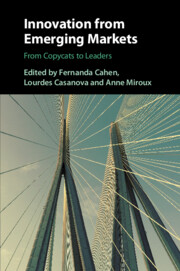Book contents
- Innovation from Emerging Markets
- Innovation from Emerging Markets
- Copyright page
- Contents
- Figures
- Tables
- Boxes
- Contributors
- Foreword
- Acknowledgments
- Introduction
- 1 A Framework for Innovation in Emerging Markets
- Part I Drivers of Innovation in Emerging Markets
- Part II Types of Innovation in Emerging Markets
- 7 The Political Economy of China’s R&D Internationalization
- 8 Emerging Pharmaceutical Companies from China, India, and Brazil
- 9 Reverse Innovation and the Role of Local Partners in Emerging Markets
- 10 Innovation Based on Value Co-creation through Employees at HCL Technologies
- 11 Frugal Innovation in Brazilian Multinationals
- 12 Innovation in War and Peace
- Part III Innovation Outcomes in Emerging Markets
- Conclusions
- Index
- References
8 - Emerging Pharmaceutical Companies from China, India, and Brazil
From Generic Drugs to Innovation Strategies
from Part II - Types of Innovation in Emerging Markets
Published online by Cambridge University Press: 15 March 2021
- Innovation from Emerging Markets
- Innovation from Emerging Markets
- Copyright page
- Contents
- Figures
- Tables
- Boxes
- Contributors
- Foreword
- Acknowledgments
- Introduction
- 1 A Framework for Innovation in Emerging Markets
- Part I Drivers of Innovation in Emerging Markets
- Part II Types of Innovation in Emerging Markets
- 7 The Political Economy of China’s R&D Internationalization
- 8 Emerging Pharmaceutical Companies from China, India, and Brazil
- 9 Reverse Innovation and the Role of Local Partners in Emerging Markets
- 10 Innovation Based on Value Co-creation through Employees at HCL Technologies
- 11 Frugal Innovation in Brazilian Multinationals
- 12 Innovation in War and Peace
- Part III Innovation Outcomes in Emerging Markets
- Conclusions
- Index
- References
Summary
This chapter presents the evolution of the pharmaceutical industry in the emerging world. It draws on firm-level cases in three of the largest pharmaceutical markets: China (2), Brazil (6) and India (11). Pharmaceutical companies in these countries have emerged as leaders in the generic segment and some are making remarkable strides towards innovation strategies. China’s Jiangsu Hengrui Medicine, India’s Sun Pharma, and Brazil’s Eurofarma are suggestive of the shift toward innovation. These companies have evolved from copycats to creative imitators and recently have been moving up the value chain in pharmaceutical R&D.
- Type
- Chapter
- Information
- Innovation from Emerging MarketsFrom Copycats to Leaders, pp. 222 - 255Publisher: Cambridge University PressPrint publication year: 2021



